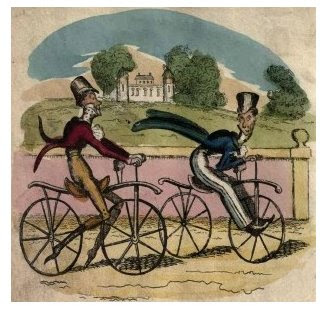 Image above from: The Dandy's Perambulations, 1819, from Dandyism.net
Image above from: The Dandy's Perambulations, 1819, from Dandyism.netON 5 April 1815, Mount Tambora in Indonesia began to grumble. A week later the volcano blew its top in a spectacular eruption that went on until July. It was the biggest eruption in recorded history, killing around 92,000 people and ejecting so much ash into the atmosphere that average global temperatures dipped by 3 °C. In the northern hemisphere 1816 became known as the year without a summer. New England had blizzards in July and crops failed. Europe was hit just as badly.
On holiday by Lake Geneva the 18-year-old Mary Shelley and her husband Percy were trapped in Lord Byron's house by constant rain. To divert his guests Byron suggested a competition to write a ghost story. The result was Mary Shelley's Frankenstein. Across the border in the German state of Baden the soaring price of oats prompted the 32-year-old Karl Drais to invent a replacement for the horse - the first bicycle.
From Histories: Brimstone and Bicycles
Jane Austen died the year a two-wheeled bicycle called the running machine was invented in 1817. Chances are she would never have mentioned such a marvelous invention as the velocipede in her novels, as one is hard pressed to recall her descriptions of ground breaking scientific advances of the Georgian and Regency eras as the steam locomotive, macadam roads, small pox vaccinations, and hot air balloons. The industrial revolution was in full swing in Great Britain by the early 19th century, and bicycles were but one byproduct of that heady, inventive time.

Karl Drais' design was made of wood (see Karl in the picture above,) and boasted a seat and handle bars, but it came with no pedals. Nevertheless, by pushing with one's feet this invention could go as fast as 10 miles per hour. Karl's contraption was called several names, including the Draisienne and the dandy horse in England - an allusion to the fact that the dandy horses riders were mostly dapper young men with too much money on their hands. Intellectual property rights were still in their infancy and the bicycle was widely copied. Subsequently, Drais never made a huge sum of money from his invention.

Karl Drais' design was made of wood (see Karl in the picture above,) and boasted a seat and handle bars, but it came with no pedals. Nevertheless, by pushing with one's feet this invention could go as fast as 10 miles per hour. Karl's contraption was called several names, including the Draisienne and the dandy horse in England - an allusion to the fact that the dandy horses riders were mostly dapper young men with too much money on their hands. Intellectual property rights were still in their infancy and the bicycle was widely copied. Subsequently, Drais never made a huge sum of money from his invention.


3 comments:
Would Mr Darcy have ridden a bicycle? Could Lizzie have coaxed him into it? Or laughed at him when he tumbled?
Great post!
It's funny how we tend to think of bicycles as more Victorian or Edwardian than Georgian, even though they were.
Bicycles always make me think of A Room with a View and those great Sherlock Holmes adaptations from the 80s with Jeremy Brett.
Really interesting, nice one!
Me, I remember that sequel of Princess Diary when Princess Mia's lover rode an old style bicycle (the one with the front wheel much larger than the back wheel); that was soo hilarious!
I don't like that guy so much... but the scene made me bent-double laughing.
Post a Comment